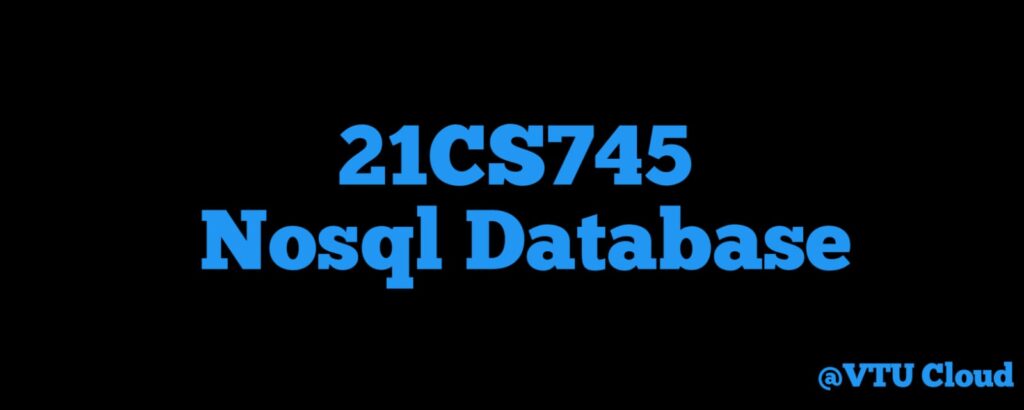21CS745 Nosql Database

Course Learning Objectives
CLO 1. Recognize and Describe the four types of NoSQL Databases, the Document-oriented, KeyValue
CLO 2. Pairs, Column-oriented and Graph databases useful for diverse applications.
CLO 3. Apply performance tuning on Column-oriented NoSQL databases and Document-oriented
NoSQL Databases.
CLO 4. Differentiate the detailed architecture of column oriented NoSQL database, Document
database and Graph Database and relate usage of processor, memory, storage and file system
commands.
CLO 5. Evaluate several applications for location based service and recommendation services. Devise an application using the components of NoSQL.
SYLLABUS COPY
IMPORTANT QUESTIONS
IMPORTANT QUESTIONS SOLUTIONS
MODEL PAPER
MODEL PAPER SOLUTIONS
RNSIT NOTES
MODULE - 1
Why NoSQL? The Value of Relational Databases, Getting at Persistent Data, Concurrency, Integration, A (Mostly) Standard Model, Impedance Mismatch, Application and Integration Databases, Attack of the Clusters, The Emergence of NoSQL, Aggregate Data Models; Aggregates, Example of Relations and Aggregates, Consequences of Aggregate Orientation, Key-Value and Document Data Models, Column-Family Stores, Summarizing AggregateOriented Databases. More Details on Data Models; Relationships, Graph Databases, Schemaless Databases, Materialized Views, Modeling for Data Access,
MODULE - 2
Why NoSQL? The Value of Relational Databases, Getting at Persistent Data, Concurrency, Integration, A (Mostly) Standard Model, Impedance Mismatch, Application and Integration Databases, Attack of the Clusters, The Emergence of NoSQL, Aggregate Data Models; Aggregates, Example of Relations and Aggregates, Consequences of Aggregate Orientation, Key-Value and Document Data Models, Column-Family Stores, Summarizing AggregateOriented Databases. More Details on Data Models; Relationships, Graph Databases, Schemaless Databases, Materialized Views, Modeling for Data Access,
MODULE - 3
Map-Reduce, Basic Map-Reduce, Partitioning and Combining, Composing Map-Reduce Calculations, A Two Stage Map-Reduce Example, Incremental Map-Reduce Key-Value Databases, What Is a Key-Value Store, Key-Value Store Features, Consistency, Transactions, Query Features, Structure of Data, Scaling, Suitable Use Cases, Storing Session Information, User Profiles, Preference, Shopping Cart Data, When Not to Use, Relationships among Data, Multioperation Transactions, Query by Data, Operations by Sets
MODULE - 4
Document Databases, What Is a Document Database?, Features, Consistency, Transactions, Availability, Query Features, Scaling, Suitable Use Cases, Event Logging, Content Management Systems, Blogging Platforms, Web Analytics or Real-Time Analytics, E- Commerce Applications, When Not to Use, Complex Transactions Spanning Dif erent Operations, Queries against Varying Aggregate Structure
MODULE - 5
Graph Databases, What Is a Graph Database?, Features, Consistency, Transactions, Availability, Query Features, Scaling, Suitable Use Cases, Connected Data, Routing, Dispatch, and Location-Based Services, Recommendation Engines, When Not to Use
Course outcome
At the end of the course the student will be able to:
CO1. Demonstrate an understanding of the detailed architecture of Column Oriented NoSQL databases,
Document databases, Graph databases.
CO2. Use the concepts pertaining to all the types of databases.
CO3. Analyze the structural Models of NoSQL.
CO4. Develop various applications using NoSQL databases.
Suggested Learning Resources
Textbooks 1. Sadalage, P. & Fowler, NoSQL Distilled: A Brief Guide to the Emerging World of Polyglot Persistence, Pearson Addision Wesley, 2012 Reference Books 1. Dan Sullivan, “NoSQL For Mere Mortals”, 1st Edition, Pearson Education India, 2015.
2. Dan McCreary and Ann Kelly, “Making Sense of NoSQL: A guide for Managers and the Rest of
us”, 1st Edition, Manning Publication/Dreamtech Press, 2013.
3. Kristina Chodorow, “Mongodb: The Definitive Guide- Powerful and Scalable Data Storage”, 2nd
Edition, O’Reilly Publications, 2013.